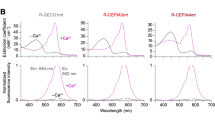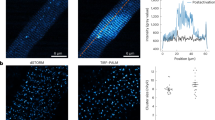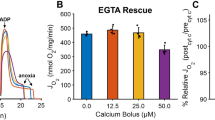Abstract
It has been proposed that the trans-sarcolemmal influx of Ca2+ occurring during the plateau of the mammalian cardiac action potential is insufficient in itself to activate the myofilaments, but can trigger a release of Ca2+ from the sarcoplasmic reticulum (SR) which is sufficient for activation1. The demonstration of this Ca2+-induced release of Ca2+ relied entirely on experiments in which the tension developed by the myofilaments was used as a sensor of the changes of myoplasmic free Ca2+ concentration ([free Ca2+]) in segments of single cardiac cells from which the sarcolemma had been removed by microdissection (skinned cardiac cells)1. The small size of these preparations has previously prevented the use of more direct methods for the detection of myoplasmic Ca2+ movements2–4. The present study is a direct demonstration of Ca2+-induced release of Ca2+ from the SR of skinned cardiac cells treated with chlorotetracycline (CTC), a fluorescent chelate probe which enables changes in the amount of Ca2+ bound to a variety of biological membranes or micelles to be monitored5–8. The fluorescence increases when more Ca2+ is bound.
This is a preview of subscription content, access via your institution
Access options
Subscribe to this journal
Receive 51 print issues and online access
$199.00 per year
only $3.90 per issue
Buy this article
- Purchase on Springer Link
- Instant access to full article PDF
Prices may be subject to local taxes which are calculated during checkout
Similar content being viewed by others
References
Fabiato, A. & Fabiato, F. J. Physiol., Lond. 249, 469–495; 497–517 (1975).
Ford, L. E. & Podolsky, R. J. J. Physiol., Lond. 223, 1–19; 21–33 (1972).
Endo, M. & Blinks, J. R. Nature new Biol. 246, 218–221 (1973).
Ashley, C. C., Moisescu, D. G. & Rose, R. M. in Calcium Binding Proteins (eds Drabikowski, W., Strzelecka-Golaszewska, H. & Carafoli, E.) 609–642 (Elsevier, Amsterdam, 1974).
Caswell, A. H. & Hutchison, J. D. Biochem. biophys. Res. Commun. 42, 43–49; 43, 625–630 (1971).
Jilka, R. L. & Martonosi, A. N. Biochem. biophys. Acta 466, 57–67 (1977).
Carvalho, C. A. M. & Carvalho, A. P. Biochim. biophys. Acta 468, 21–30 (1977).
Chandler, D. E. & Williams, J. A. Nature 268, 659–660 (1977).
Fabiato, A. & Fabiato, F. J. Physiol., Lond. 276, 233–255 (1978); Ann. N.Y. Acad. Sci. 307, 491–522 (1978); J. Physiol., Paris 75, in the press (1979).
Carafoli, E. in Recent Advances in Studies on Cardiac Structure and Metabolism Vol. 5 (eds Fleckenstein, A. & Dhalla, N. S.) 151–163 (University Park Press, Baltimore, 1975).
Southard, J. H. & Green, D. E. Biochem. biophys. Res. Commun. 59, 30–37 (1974).
Åkerman, K. E., Saris, N.-E. L. & Järvisalo, J. O. Biochem. biophys. Res. Commun. 58, 801–807 (1974).
Millman, M. S. & Haynes, D. H. Biophys. J. 25, 26a (1979).
Cohen, S. M. & Burt, C. T. Proc. natn. Acad. Sci. U.S.A., 74, 4271–4275 (1977).
Costantin, L. L. & Taylor, S. R. J. gen. Physiol. 61, 424–443 (1973).
Trautwein, W., McDonald, T. F. & Tripathi, O. Pflügers Arch. Ges. Physiol. 354, 55–74 (1975).
Luthra, R. & Olson, M. S. Archs. Biothem. Biophys. 191, 494–502 (1978).
Author information
Authors and Affiliations
Rights and permissions
About this article
Cite this article
Fabiato, A., Fabiato, F. Use of chlorotetracycline fluorescence to demonstrate Ca2+-induced release of Ca2+ from the sarcoplasmic reticulum of skinned cardiac cells. Nature 281, 146–148 (1979). https://doi.org/10.1038/281146a0
Received:
Accepted:
Issue Date:
DOI: https://doi.org/10.1038/281146a0
This article is cited by
-
Profiling the Ca2+ spark dynamics in live cardiomyocytes
Nature Cardiovascular Research (2023)
-
Lights, camera, path splitter: a new approach for truly simultaneous dual optical mapping of the heart with a single camera
BMC Biomedical Engineering (2019)
-
Comparison of the Effects Exerted by Luminal Ca2+ on the Sensitivity of the Cardiac Ryanodine Receptor to Caffeine and Cytosolic Ca2+
Journal of Membrane Biology (2006)
-
Calcium sequestration by isolated sarcoplasmic reticulum: real-time monitoring using ratiometric dual-emission spectrofluorometry and the fluorescent calcium-binding dye indo-1
Molecular and Cellular Biochemistry (1990)
Comments
By submitting a comment you agree to abide by our Terms and Community Guidelines. If you find something abusive or that does not comply with our terms or guidelines please flag it as inappropriate.



